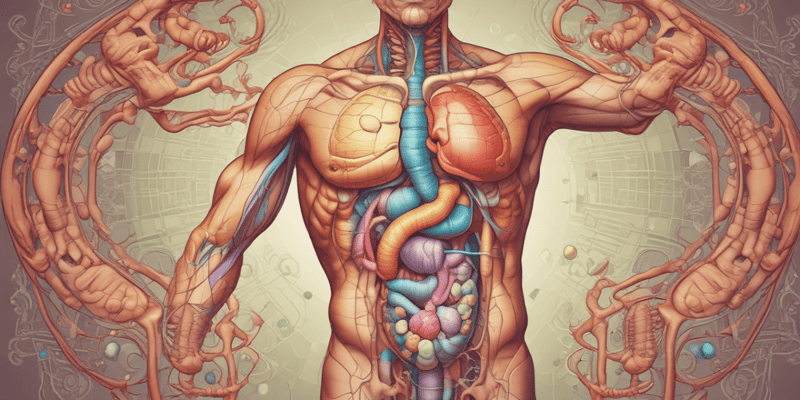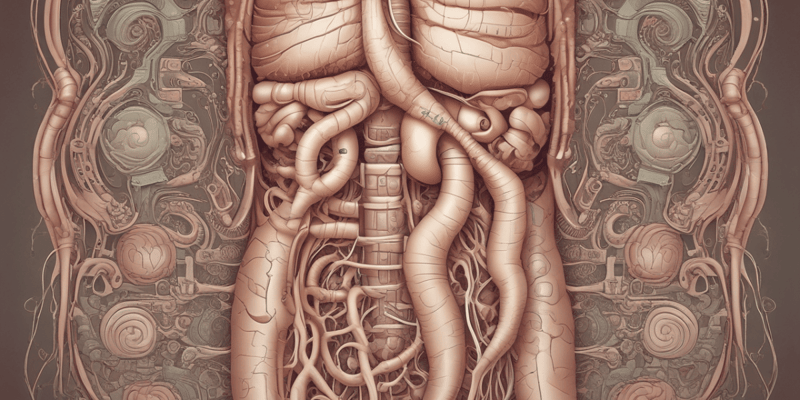12 Questions
What are the major kinds of salivary secretions and their function?
Electrolytes and proteins (e.g. amylase); Saliva lubricates food for swallowing and aids in starch digestion.
Which phase of acid secretion is activated by sight, smell, taste, and chewing of food?
Cephalic
What factors evoke the gastric phase of secretion?
Distension and chemical composition of food
What hormone is secreted in excess in Zollinger-Ellison Syndrome?
Gastrin
Parietal cells secrete pepsinogen in the stomach.
False
Excess acid secretion in Zollinger-Ellison Syndrome can lead to peptic ulcers as well as ___ and other symptoms.
diarrhea
Pancreatic juice is rich in HCO3 for neutralizing duodenal content.
True
What are the four major organs in the digestive tract after the mouth?
Esophagus, stomach, small intestine, large intestine
What is the primary propulsion force in the digestive tract?
Involuntary muscular contraction (peristalsis)
Carbohydrate digestion is initiated in the oral cavity through the action of lipase.
False
_______ cells release hormones that affect the physiological activity of the GI tract.
Endocrine
Match the following vitamins with their types: A, B, C, D, E, K
A = Fat-soluble B = Water-soluble B-complex group C = Water-soluble B-complex group D = Fat-soluble E = Fat-soluble K = Fat-soluble
Study Notes
Overview of the Digestive System
- The digestive system consists of four major organs: esophagus, stomach, small intestine, and large intestine
- Each organ has a specific function in the digestion and absorption of nutrients
- The digestive system is controlled by both involuntary and voluntary muscles
Structure of the GI Tract
- The GI tract has four concentric layers: mucosa, submucosa, muscularis externa, and serosa
- Mucosa: epithelium, lamina propria, and muscularis mucosae
- Submucosa: large blood vessels, lymphatic vessels, and nerves
- Muscularis externa: two layers of smooth muscle, inner circular and outer longitudinal
- Serosa: loose connective tissue and mesothelial cells
Functions of the GI Tract
- Mechanical digestion: breakdown of food into smaller particles
- Chemical digestion: breakdown of nutrients into absorbable forms
- Absorption: uptake of nutrients into the bloodstream
- Elimination: removal of waste products
Innervation of the GI Tract
- Both autonomic motor and sensory fibers are present in the GI tract
- Parasympathetic and sympathetic motor fibers stimulate and inhibit gut function, respectively
- Intramural ganglia: myenteric plexus (Auerbach) and submucosal plexus (Meissner)
Digestion and Absorption of Nutrients
- Digestion of carbohydrates, proteins, and fats occurs in the mouth, stomach, and small intestine
- Absorption of nutrients occurs in the small intestine through various transport mechanisms
- Pancreatic and liver secretions aid in digestion and absorption
Endocrine Control of the GI Tract
- Hormones regulate gut function, including gastrin, cholecystokinin, and secretin
- Endocrine cells are distributed throughout the epithelia of the stomach, small intestine, and pancreas
Salivary, Gastric, and Pancreatic Secretions
- Salivary glands produce saliva, which aids in digestion and lubrication of food
- Gastric secretion: stomach secretes acid, pepsin, and intrinsic factor
- Pancreatic secretion: pancreas secretes digestive enzymes and bicarbonate-rich fluid
Intestinal Absorption of Nutrients
- Absorption of amino acids, sugars, and fats occurs in the small intestine
- Transport mechanisms include active transport, facilitated diffusion, and passive diffusion
- Gut hormones regulate gut function and nutrient absorption### Oxyntic Gland Structure and Function
- Oxyntic gland is the key site of gastric HCl secretion, composed of three regions: isthmus (parietal and surface mucous cells), neck (parietal and mucous cells), and base (chief cells that secrete pepsinogen) with some endocrine cells.
- Gastrin-producing cells (G-cells) are localized in the middle third of the mucosa.
- Parietal cells are more abundant in the pylorus than in the cardiac region, while chief cell distribution is reversed.
Cellular Components
- Surface mucous cells: simple columnar epithelium, secrete neutral carbohydrate-rich glycoproteins, and have a 1-week renewal period.
- Mucous neck cells: larger mucous granules than surface cells, stem cells for epithelial replacement, secrete acidic glycoproteins.
- Parietal or oxyntic cells: secrete 0.1 N HCl, located in the middle and upper part of the gastric gland, 25 µM diameter, with numerous mitochondria, specialized intracellular canaliculi, and microvilli on lumen and canaliculi walls.
Regulation of Acid Secretion
- Gastrin released by G cells of antral mucosa and the first part of the duodenum into the bloodstream, stimulating parietal cells (endocrine mechanism).
- Histamine released from enterochromaffin-like cells in response to gastrin, diffuses to parietal cells, and stimulates acid secretion (paracrine mechanism).
- PGE2 inhibits acid secretion by binding to an EP3 receptor on the basolateral membrane of the parietal cell, reducing histamine release from ECL cells and gastrin from antral G cells.
Gastric Juice Composition
- Gastric juice is a complex solution of acidic components (HCl) from parietal cells and alkaline components containing pepsinogen from peptic cells and electrolytes like Cl, Na, and K from several cell types.
Phases of Gastric Acid Secretion
- Acid secretion is divided into basal (fasting) and stimulated (post-prandial) phases.
- Cephalic phase: activated by sight, smell, taste, and chewing of food; mediated by efferent impulses through vagus fibers to the stomach and abolished by vagotomy.
- Gastric phase: food enters the stomach, stimulating reflex acid secretion without releasing gastrin.
- Intestinal phase: food enters the intestine, stimulating acid secretion, which can be inhibited by intestinal acid, fat, and hyperosmolar solutions.
Zollinger-Ellison Syndrome
- A rare condition characterized by tumors in the pancreas or duodenum, secreting large amounts of gastrin, leading to increased HCl secretion, peptic ulcers, and diarrhea.
Regulation of Pancreatic Secretion
- Human pancreas: 90-100 g, located near the duodenal loop, and supplied by the pancreatic duct.
- Mixed endocrine and exocrine gland with acinar cells forming 82% of the volume and endocrine tissue dispersed throughout exocrine tissue.
- Secretion of pancreatic juice: highest rate of protein synthesis, with an aqueous component rich in HCO3, and an enzyme component containing proteolytic enzymes, lipase, and amylase.
- Secretin elicits aqueous and cholecystokinin pancreatic enzymes and fluid secretion.
Lecture notes for Prof GE Mann's GI Lectures 1-5, providing a summary of concepts and information delivered in each narrated PowerPoint lecture.
Make Your Own Quizzes and Flashcards
Convert your notes into interactive study material.
Get started for free



